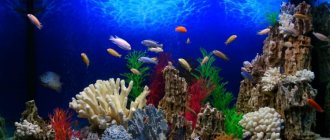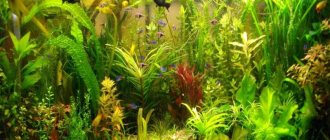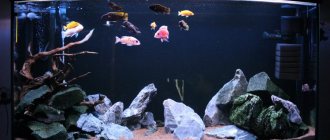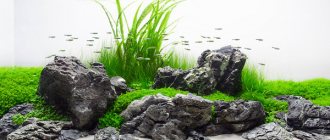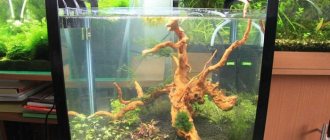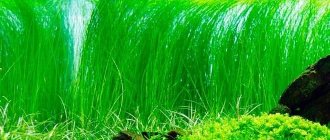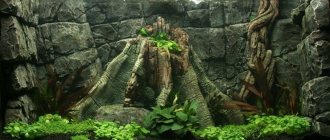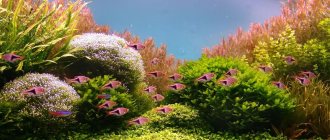Aquascaping refers to the art of creating amazing landscapes within an aquarium. Only creative and educated people can make a masterpiece. Before starting to renovate, the idea is embodied on paper and only after adjustments is implemented. Aquascaping for beginners involves mastering styles and techniques, as well as creating simple compositions. Further development in this direction will make it possible to practice this type of art professionally.
Aquascaping is one of the areas of aquadesign
What does “natural style” mean?
Natural design of aquariums originated in the 90s; the founder of the idea is considered to be the Japanese Takashi Amano. When composing the compositions, he was guided by the principles of creating Japanese gardens. The direction quickly became known and popular all over the world. The main task of the natural style is to replicate the terrestrial landscape within the aquarium as accurately as possible.
Creating an aquascape with your own hands is a labor-intensive task that requires a complex of knowledge and experience. Studying theory and regularly developing skills will help you achieve good results.
Mistakes made by amateur aquascapers when decorating aquariums
Aquascape is a very, very exciting and calming activity. Many people, before doing it, read specialized literature, watch educational videos and photographs of the results of the work of masters. In other words, they take accelerated correspondence courses. It is quite natural that, with insufficient knowledge and lack of experience, novice aquascapers make mistakes, several of which can be classified as typical, that is, the most frequently repeated. It is worth dwelling on them in more detail.
Basic aquascape styles
Despite the fact that aquascaping is a young art form, many people want to create underwater paintings. The variety of natural materials makes it possible to implement a large number of ideas. As a result of the development of aquascape, directions were developed, each of which has its own characteristics and features. Despite the fact that it includes more than a dozen styles, the main ones are preferred.
Iwagumi - the art of arranging stones
The rock garden is built in stages: blocks are installed first, then low-growing plants, and at the end the grass. Vegetation and fish are present in minimal quantities, attention is given to stones. They should not affect water quality or oppress flora and fauna.
When decorating iwagumi, large stones are used
Rules for placing stones have been developed:
- present in odd numbers;
- you cannot arrange them in a straight line or obey any pattern; everything is done according to intuition;
- objects are fixed to ensure their stability;
- each stone has its own parameters;
- Do not use smooth objects, they spoil the naturalness of the picture.
Garden-Zen – harmony and peace
The style is characterized by the creation of a single elegant composition. Emerged from philosophical Zen teachings based on harmony and tranquility. An aquascape with driftwood and Japanese stones is used in the landscape. Vegetation is either absent or represented by mosses. Design elements, their shape and arrangement are subject to the rules of Zen Buddhism. Landscapes in this style are used for meditation.
Wabi kusa – floating elements and mosses
The main feature of the direction is the presence of surface objects. In the middle of the composition, a hummock or mound is formed, which is densely covered with vegetation, and the top is visible above the surface of the water. Thus, small islands are formed above the surface.
Dutch style
It is considered difficult and time-consuming to compile. Distinctive features are strict zoning, planting a dense group of plants, caring for them and timely cutting.
Style Basics:
- The number of plant species used depends on the scale of the aquarium. Each group occupies at least 10 centimeters of the length of the container.
The Dutch aquarium is easily recognized by its abundant vegetation
- A variety of flora is welcome. Differences in size, growth and color between species make the composition colorful and rich.
- Vegetation is distributed into the foreground, middle and background. Each zone has a specific species.
- The background is dark, in gloomy colors. Brown and black shades are suitable.
The listed styles have long become classics in aquascaping. However, with the development of modern art, new trends are emerging, the popularity of which is gradually gaining momentum.
Aquascaping - what is it? Basics, main rules and secrets for creating the right composition.
What is aquascaping?
Aquascaping (from the English aquascaping - creating a water landscape, landscape) is the artistic design of aquariums, one of the types of decorative and applied art. This type of art is a kind of aquarium analogue of landscape design.
Getting started with aquascaping is actually not difficult. Whether you are just deciding or have already decided to start your own aquarium, it is important to understand that aquascaping, like any other passion or hobby, requires time, dedication and extensive knowledge.
This article is like a foundation before starting to build a house! In it you will receive the basic and, in principle, the most important basic knowledge related to aquascaping, from establishing simple principles and rules of visual design and setup to familiarizing yourself with the basics of building an aquascape, developing based on the most famous types of aquariums with plants and, of course, valuable suggestions advice and suggestions on the composition and layout of aquascaping.
By adhering to the information received, you will definitely become closer to your dream. After all, dreams definitely come true, don’t forget about it!
What is aquascaping?
In recent years, aquascaping has become increasingly popular among aquarists. A comprehensive definition of the term describes aquascaping as “underwater gardening,” which includes techniques for creating, decorating, and arranging an array of elements—aquatic plants, rocks, driftwood, and other decorations.
However, unlike conventional gardening, aquascaping involves a much longer and perhaps more complex development path. Let's face it, passionate aquarists know that there's more to keeping fish than just raising them. Also, aquascaping is not only about showing interest in the beautiful and exciting species of aquatic plants and living organisms living in the aquarium. Once aquariums become a part of our home, they become our pride, they appear in our daily conversations and fulfill our hidden dreams by allowing us to showcase our creativity and imagination.
In addition to the growing discipline of aquatic gardening that includes physiology, pruning, balance and aquarium care, aquascaping also involves rules regarding design and layout that extend beyond the aquarium itself. Getting the perfect aquarium is not easy, but once you decide to “get into it,” aquascaping will begin to be fun.
Basic principles of aquascaping
The entire process of aquascaping may seem like a difficult task to complete, but it is not as difficult as it seems if you follow a simple set of principles and rules.
As with any creative development, aquascaping relies heavily on a trusted source of knowledge and relies heavily on your imagination. Achieving the perfect balance between effectively applied scientific principles and creativity, the latter may be the most difficult for you to achieve.
Here are a couple of criteria to consider before getting started with aquascaping:
- Simplicity - Aquascaping is all about taste and usually the fewer elements the more you get. It's very simple, often people are tempted to add as many plant species as possible, believing that this will provide great visual variety, but in most cases the result will be the opposite.
- Variety - Keeping it simple doesn't mean using just one type of plant. Remember that imagination is key in aquascaping!
- Proportion – It is very important to give the aquarium a sense of harmony, so try to have as much open space as possible. Avoid using only large leafy plants. Such plants break the entire proportion and depth of your aquascape.
- Persist – Aquascaping can be frustrating, be confident! Don't be afraid to make adjustments, be willing to deconstruct and reconstruct if you don't like something about it. The more you experiment, the more experience you will gain.
Aquascaping Basics
Lighting. One of the most important pieces of aquascaping equipment, it has a decisive influence on the healthy appearance and growth of plants. Lighting is considered the operating heart of an aquarium.
Water filter. As the name suggests, the purpose of the filter is to remove excess food, fish waste, hazardous chemicals and decomposing organic matter in the aquarium. There are three main methods of water filtration: mechanical, biological and chemical. Most aquarium filters on the market include a combination of two cleaning methods.
Carbon Dioxide - The CO² system can be a little expensive, but it is essential for plant growth. No plant grows without carbon dioxide, period. Those aquarists who are truly passionate about aquascaping think long term and know that purchasing a good CO2 system will allow them to grow their plants properly.
Liquid fertilizers. Think of fertilizers as the vitamins and minerals your body needs to stay alert and strong. Depending on the lighting and CO² systems in your aquarium, there are two types of fertilizers you can use to keep it healthy: macronutrients and micronutrients. To create ideal conditions and a suitable aquatic environment for aquarium plants, these fertilizers must be dosed in the correct proportions.
Substrate (soil). Plants in an aquascape absorb nutrients not only through their leaves, but also through their roots, so choosing the right aquascape substrate is very important. Depending on the plants you want to grow (small foreground, tall background, moderately tall middle background, etc.), the right substrate will ensure their proper size, development and leaf color.
Hardscape decorations (rocks and driftwood). To ensure the aesthetics of an aquarium, plants alone are usually not enough. You need to add stones, driftwood, sand, etc. Make them as unique as possible and arrange them in an unusual but attractive way just like in nature. Decorations are essential elements that support the design and are part of the layout and entire aquascaping process.
Elementary rules regarding the visual construction and setup of aquascaping
Aquascaping may be an art form where imagination and creativity play an important role, but mastering the basics of the process is basic if you really want to succeed.
Measure is very important in nature, and aquascaping is no exception. Do you want your aquarium to not only please your eye, but also make it stop in the right places? Do you want your fish to feel comfortable? Do you want your plants to grow to their full potential? You can do all this by following a set of really simple mathematical rules. Yes, in order to become beautiful, unpredictable and diverse, nature is “mathematical”. Read on to find out what this means.
Rule of thirds
The rule of thirds is a principle of composition based on the simplified rule of the golden ratio. The rule of thirds applies to drawing, photography and design.
It is true that beauty is in the eye of the beholder, but it is also true that the eye of the beholder can be easily controlled. Any artist knows this and uses it. Aquascaping is all about creating captivating visual effects, suggesting to the eye where to look first and what to slide to next.
The Rule of Thirds refers specifically to how we can use imaginary references, knowing how to place certain elements in our space in such a way that we can control what the viewer's eye sees. To understand how the rule of thirds works, try drawing an image divided into nine equal parts by two equally spaced horizontal lines and two equally spaced vertical lines.
The purpose of these imaginary lines is actually to find grid intersection points where you can set the focus of the image, a special mark that first anchors the viewer's eye and from which the viewer's eye can glide to other points of interest. This rule makes the viewer more interesting, exciting, relaxing and enjoyable. Placing a focal point in the middle of your aquarium distracts the eye from what is placed around it.
Golden ratio
The golden ratio is a ratio of dividing lengths or distances, which is used mainly in the visual arts, but also in architecture and even in music. In fact, you can easily find the golden ratio in nature, for example, in the arrangement of plant leaves. A layout based on this principle is especially harmonious for the human perception of beauty. In aquarium design and especially in aquascaping, the golden ratio principle can be used as a basis for structuring the layout and setting focal points.
Creating an aquascape in an aquarium can be difficult for those new to aquascaping. If you are one of those hobbyists who have no idea about creating an aquascape, you can use the golden ratio rule as a guide to help you go in the right direction when decorating your aquarium.
When designing your aquarium, the main goal of creating an aquascape is to create an enjoyable piece of art that harmonizes with the beauty of life. An aquascape should only have one main focal point. Multiple focal points will force the viewer's eye to constantly move, which in turn can lead to eye strain and ruin the entire look of the aquarium. Having an accent in an aquascape is very important as it gives the viewer an idea of what to look for first. The lack of a focal point can cause the viewer to look at the entire aquarium, which in turn is incorrect.
The origins of the golden ratio begin with Greek mathematicians. By dividing the lines into an extreme and an average ratio, also known as the golden ratio, the Greeks were able to obtain a ratio of 1:1.618. This ratio has been used in many forms of art and has always successfully pleased the human eye. This golden ratio is best used in medium-sized aquariums with a total volume of 60 to 180 liters. Anything smaller than a 60 liter aquarium will leave the focal point largely visible, thus may be the only focal point of the aquascape, and anything larger than 180 liters will have too much space and may generally need second focal point. Unless you are an experienced aquascaper, we recommend using this rule only for aquariums between 60 and 180 liters.
To use the golden ratio rule when designing your aquarium, we need to measure its length and height, after which we need to find the focal point or points.
For example, consider an aquarium with a volume of 75 liters with a width of 60 cm and a height of 40 cm.
Divide the length of your aquarium by 2.618, in our example it is 60/2.618=22.9. We got the length of the short side - it is approximately 22.9 cm. Using this length we draw a vertical line from the bottom to the top of the aquarium. As a result, we received two sections, the length of the first section was 22.9 cm, the length of the second was 37.1 cm.
Now do the same with the height of your aquarium. In our example, 40/2.618=15.27. We got the height of the low section - it is approximately 15.27 cm. Using this size, draw a horizontal line from left to right. We again have two sections in our aquarium, the height of one will be 15.27 cm, and the second 24.73 cm.
As a result of these simple manipulations, we found one intersection point. This point is called the focal point or as it is also called the focal point.
The intersection points of horizontal and vertical lines are called focal points. The gaze of the person looking at the picture is directed to the focal points, and this happens subconsciously. Therefore, the focal point is the ideal place to place the main subject.
This will be the area of our “focal point” when designing an aquarium. In our example, we used the bottom left part of the aquarium to calculate and find the focal point, but in fact it can be found either in the bottom right part or the top part of the aquarium. It all depends on your imagination and the specifically conceived composition in the aquarium.
Golden spiral
The Golden Spiral is another useful image design aid that is also based on the Golden Ratio. Its shape can be approximated by successive quarter circles that rotate 90° and decrease by a certain factor with each iteration. This results in a particularly harmonious spiral shape, reminiscent of a snail shell. If you navigate with this curved shape, objects and focal points can be uniquely placed in the image and this helps with the visual perception of your aquarium compositions. Because of its special shape, the result is a little more dynamic than with the classic golden ratio or rule of thirds grid. Of course, you can also rotate or flip the golden spiral to experiment with this option.
For example, in the aquascape shown below, notice how perfectly the plants fit into the golden ratio. The large moss-covered branch is the focal point of the entire aquascape, with the thickest part of the branch falling right into the center of the golden spiral. Also, notice how densely planted the plants to the left of the vertical line are compared to the right side of the vertical line. The dark plants in the lower right corner of the aquarium frame the entire aquascape in an inclined spiral of the Golden Ratio.
Conclusion. Using and adjusting focal points in an aquarium.
When drawing or creating an aquarium layout, you can use the golden ratio grid, rule of thirds, or golden spiral to divide and define the spaces in your aquarium. First of all, these techniques will help you avoid strong symmetries that will make your aquascape look unnatural, artificial, or simply boring and static. When composing according to the rules of the golden ratio, the painting will look much more natural because the composition will look less harsh or, frankly, look a little more crooked and wobbly and therefore more natural.
In simple terms, focal points (foci) that attract the viewer's attention are often placed on intersecting lines when the rule of thirds or the golden ratio is used. With a golden spiral, the smaller tail of the spiral indicates the area that offers itself as the focal point. In the aquarium, you can use particularly beautiful aquatic plants or other elements such as pieces of driftwood or individual stones. Don't be afraid to experiment, be sure to plan to draw a layout on paper and start creating your first masterpiece. You will definitely succeed.
If you liked the article, repost it or share the knowledge with your friends!
© Copying of materials presented on this site is permitted only if there is an active backlink.
What are the rules for arranging elements?
The creation of aquascaping proceeds in stages. Filling the aquarium with individual objects occurs according to the developed rules:
- the largest and most significant elements are installed first;
- nearby plants for creating an aquascape differ in size and shape;
- the location of the main part of the composition is calculated according to the golden ratio rule;
- if the aquarium is small, one visual point is made; for large containers, two are acceptable.
Regardless of the style in which aquascaping will be performed, the work must be harmoniously designed, and the arranged elements must correspond to a single idea.
In a small aquarium there should be only one visual center
I also highlighted the factors influencing the choice of the type of arrangement of stones:
- Presence of live or dry/artificial stones
- Volume of stones
- Aquarium size
- Experience and knowledge of marine system maintenance
- Location of the drain column
The leading factor is the volume and type of stones.
Owners of living stones overwhelmingly use types of installation from the “island” category . The combination of factors “location of the drainage clone”, “experience and knowledge of the maintenance of the marine system” and “living complex” more often contributed to the installation of the “slope” and “wall” type.
Owners of dry reef stone or artificial stones more often chose installation types from the “island” and “column” categories and significantly less often other types.
Of course, the “column” is the prerogative of the owners of IBS and artificial stones .
The “location of the drain clone” factor was very frustrating, as it disgustingly spoiled the appearance of the magnificently beautiful aquarium systems.
Reading the cbitsiaras thread and reaching the page with the laying of stones, I almost cried - the lyrics of the sea creation were brutally destroyed by the decoration of the drain column.
LCDs, despite their popularity and “usefulness,” without the factor “experience and knowledge in maintaining the marine system” more often led to the creation of a nondescript picture - simply a dump of stones.
IBS often made it possible to create harmonious views that were truly mesmerizing.
In percentage terms, the use of GI is 60%, IBS is 40%. But it must be taken into account that all systems used the LCD tab in the display or SAMP during the startup process. On the other hand, many, in addition to LCD, also used SRC to reduce the price of the filling.
Having finished viewing foreign aquarium systems, melancholy descended on me. In the territory of the Russian-speaking audience, the majority of aquariums are 30-500 liters in apartments. Behind the cardon there is a significant part of 500, tonics and higher designed in homes.
But our “Kulibins” no, no, they create an aquarium with their own hands. And then my uncle came and did not everything, of course.
If you want to share your experience in creating decorations for your aquarium, welcome to our forum.
In the next article I will try to outline the basic principles and rules of harmonious laying of stones, taking into account the chosen design category. So subscribe to new articles on our portal.
Discussion of the article on the forum.
This article was written specifically for Aquamania.by.
Author: Komyakovich Alexander, aka voodoo, 2015
Copying of material is permitted only with a link to the source.
Join us on social networks:
Playing with visual perspective
Such a clever technique as interaction with perspective allows you to visually increase the size of the aquarium and make it spacious. The effect is achieved by distorting the parameters of decorative objects.
There are three types of perspective:
- Linear. The elements are placed at a certain angle to the wall of the aquarium. They are guided by the rule: the greater the slope, the more voluminous the picture will be. The distance method is also used. Objects are positioned in such a way that they narrow and the composition goes into the distance.
- Air. Elements installed in the distance have blurry outlines. This smooths out the boundaries, and thereby visually increases the space.
- Tonal. The volume of the landscape is achieved by darkening the front zone due to the formation of shadows. The distant background, on the contrary, is illuminated or highlighted by the presence of bright objects.
Aquarium and its contents
The desire to create a whole universe in the aquarium, making it larger will help with small fish species, plants with small foliage, deep tanks and technological advances. To erase boundaries, backlighting is often used using frameless aquariums.
Walls made of moss are for professionals. Beginners should not do this. This background makes the boundaries clearer, and the aquarium itself visually seems cramped and small.
For beginner aquascapers, it is better to take an aquarium of Asian standards. They are available in several proven sizes, which are easy to match with equipment. All plants require lighting, but among them there are very whimsical ones - ground cover. The lamps should be easy to use, penetrate the entire thickness of the water, and the lighting intensity should correspond to the level of carbon dioxide supply.
Water circulation should work according to the principle of a cycle: it is taken into the filter from the middle layers and returned to the upper ones. This will avoid stagnation. In aquascape aquariums, it is recommended to use only external canister filters.
Read about large and small aquariums, also about an aquarium for plants - herbalist.
Laying the substrate
One of the most important stages of work in aquascaping is laying the substrate, which is bottom gravel for planting plants.
It performs the following tasks:
- Rooting plants and providing them with nutrients.
- Providing microorganisms with the opportunity to multiply and perform their main function - maintaining biological balance.
- Creation of a natural landscape.
Before filling the substrate, substances are added to the bottom to keep it active for a long time and stimulate the growth of plants and microorganisms. The nutrient substrate is placed only in the planting area. In places free from vegetation, ordinary decorative sand is poured. This makes it easier to keep the top layer of soil clean. The height of any substrate should not exceed 3-5 cm.
Next, the aquarist must clearly understand what type of aquarium he wants to get, how the plants will be planted and where the stones and driftwood will be located. The structure of the landscape depends on this.
Working with the background
Correct zoning improves the quality of the composition. Usually a lot of time is spent selecting objects and lighting that will be in the foreground. The background is no less important. Its appearance depends on the theme of the landscape and the location of the aquarium. The following background design features need to be taken into account:
- bright colors can distract from the main elements of the landscape;
- if the aquarium is placed next to the wall, choose rich dark colors;
- plant themes go well with green or leafy backgrounds;
- The seascape looks harmonious with the image of the rocks.
The background can be decorated with photo wallpaper, tiles, layouts, and foam elements.
The background of the aquarium is often left dark
Aquascaping concept
In fact, the definition of the word “aquascape” is related to the English word “landscape”, which translates as “landscape”. That is, an aquascaper is, in some way, a landscape specialist, only he works on a small (relative to home and other areas around large real estate) section of area located under water.
Developing an aquarium design is working on recreating some natural picture. Of course, there are many trends in this culture, but they are all based on the fact that the aquarist takes some landscape or landscape as a basis and, using various materials, recreates it within the aquarium.
Principles of proper lighting for aquascapes
Light performs one of the main functions in creating an aquascape. It is used to highlight individual objects or entire areas to focus attention on them and create the atmosphere of the composition. Without proper lighting it will not be possible to achieve the desired effect.
To ensure that this factor complements the landscape rather than depresses it, there are two basic lighting rules:
- It must correspond to the chosen style.
- It has a beneficial effect on the life of vegetation and fish.
Comparison of compositions in different styles
The comparison table contains characteristics that are important when choosing a composition style for independent design.
| Style | Component cost | Difficulty of creation | Labor intensity of care |
| Natural | Varies from small to medium | There can be both simple and very labor-intensive landscapes | Average, depends on the selection of vegetation |
| Iwagumi | High due to special stones | The set of rules makes this type of composition the most complex. | Medium and low, as there are limited types of algae to use and the entire emphasis is on stones. |
| Dutch | Medium, as it does not require expensive hardscapes | There are difficulties associated with the painstaking selection of the plant component | High, since the main emphasis is on vegetation that needs to be trimmed to maintain the beauty of the landscape |
Tips for choosing fish
Not every design involves the presence of living creatures in the aquarium. Some styles do not imply the presence of such decor. However, fish enliven the landscape and emphasize its beauty.
When selecting aquarium fish, a number of factors are taken into account:
- Habits. While some species of underwater representatives swim calmly in the water, others may actively dig the soil or constantly hide among vegetation and stones.
- Options. The length and width of the fish should be proportional to the size of the container. Large individuals “eat up” space and distract from the composition. Small ones, on the contrary, make the aquarium spacious.
Small fish are chosen for aquascaping - Quantity. The numerical factor is also important. The presence of many fish will create chaos and confusion. Therefore, they are limited to a small flock.
- Color. Bright accents are acceptable in an aquascape. It is important that the picture is harmonious, and that too colorful fish do not look like ridiculous motley spots.
- Care. In the process of life, the inhabitants of the aquarium clog it. It is necessary to think through all the care steps so that the decorative elements are not damaged by contamination.
Style with Japanese flavor
The Iwagumi direction is one of the most difficult in aquascaping. Although at first glance the concept seems simple. Using only one or two species of slow-growing plants can cause algae problems early on. To do this, use a special dry start technique.
The Iwagumi style was created in 1985 by the famous master of aquarium design Takashi Amano. The compositions are characterized by minimalist design and reflect the characteristics of Japanese spiritual culture: the love of beauty and simplicity.
Amano created his first aquascape, Iwagumi Aquascape, in a 60cm aquarium using Senmigawa stones. The entire plantation was planted with Echinodorus tenellus only. Later, a group of red neons was placed in the water space.
Iwagumi
The term Iwagumi itself comes from the Japanese phrase “rock” and therefore refers to compositions in which stones play a leading role. Rocks provide a "hard" structure to the landscape. Traditional landscape - consists of three main stones, of which one is large and two are small.
The most difficult task is to achieve harmony and unity through simplicity. Iwagumi is not just a collection of stones, but their flowing, natural and spacious placement so that they relate to each other and to the rest of the landscape.
Some of the most popular stones used for this type of aquascape include Seiryu, Manten and Dragon's Eye, but there are no actual restrictions on the types. The goal is to build a group of stones that are similar in color and texture, but different in shape and contour.
Each stone in the Iwagumi scheme has a name and a specific role:
Oyaishi is the primordial stone. The biggest and most beautiful of all. Oyaishi is always the center of Iwagumi's scheme. It is placed according to the rule of thirds and occupies 2/3 of its height, which is the ideal ratio for the human eye, according to the theory of the golden ratio. The Oyaishi is also angled slightly in the direction of the water flow to give it a natural appearance, more like river rocks.
Fukuishi is a secondary stone that is intended to resemble Oyaishi in color and texture. It is usually placed on the right or left, being the second largest in the aquarium. The main purpose of the element is to balance the primary stone and create tension in the watery landscape.
Soeishi is the third stone, usually placed next to Oyaishi, along with Fukuishi, emphasizing the strength of the first. Suteishi - The fourth largest rock in the Iwagumi Aquarium, Suteishi is also called the "sacrificial stone" because it is not intended to be excreted and is often covered by plants. However, the role of the suteisha is to complement the entire rock, helping all the other stones create a sense of unity. In the Sanzon Iwagumi aquascape, suteishi are omitted.
When it comes to landscaping an Iwagumi style aquascape, there is a limited amount of seaweed you can use (1-3). This is necessary to emphasize the stones, which are not blocked by plants, and the open space of the aquarium, which should prevail.
The most popular are low-growing carpet plants, such as: hemianthus cube; eleocharis acicularis; glossostigma elatinoides; micranthemum umbrosum, utricularia graminifolia.
Other suggested plants for Iwagumi waterscapes are pogostemon helferi, riccia fluitans (submerged and rock-bound) and larger background plants such as vallisneria nana, eleocharis vivipara, staurogyne repens and rotala.
Aqua compositions in the Iwagumi style are distinguished by harmony and unity due to simplicity; this should not be forgotten when choosing fish. Their smooth movement should have a calming effect on the viewer.
The following types of aquarium inhabitants are excellent for Iwagumi: black neon (black neon tetra); red neon (paracheirodon axelrodi); joyomus (red-nosed tetra); Erythrosomus (glowing tetra); fire tetra (von rio); Rasbora cuneiformata (Rasbora heteromorph).
All of these species are used for their calm, non-aggressive behavior. It is recommended to place a group of at least 10–12 individuals in the aquarium.
Iwagumi composition
Advantages:
- looks beautiful and concise;
- the composition has a beneficial effect on the mood of the audience;
- Small, easy-to-care fish are predominantly used.
Flaws:
- complex rules for constructing a composition, it is easier to order a ready-made design;
- there are several traditional compositions with their own rules;
- high price: materials are expensive, since the stones are supposed to be specially selected;
- components must be specially ordered.
Common Beginner Mistakes
Those who have just decided to try their hand at aquascaping face a number of difficulties. It is possible to avoid most of them if you study typical mistakes and avoid them in your work.
The most common are:
- Lack of concept. If the idea is poorly thought out and not implemented through a sketch, it will not be possible to create a correct and harmonious landscape. You can’t do an aquascape straight away; first you need to practice on paper, think through the details, and make adjustments.
- Lack of knowledge. To practice aquascaping professionally, it is not enough to follow the basics of decor. It is necessary to understand the technical aspects of installing landscape elements, study biology and zoology.
To properly design an aquarium you need creativity and knowledge of biology. - Copying professionals. For beginners, it seems that repeating an already finished work is as easy as shelling pears. This is far from true. To make a high-level composition, the creator needed a lot of time to acquire the necessary experience and master technical skills. Even if a beginner was able to at least approximately copy the work, it will still be of poor quality.
- Violation of proportions. The elements must be in harmony with each other and the environment in which they are located. Failure to comply with this rule will make the composition ridiculous and ugly.
Creative people with good imagination need to try themselves in aquascaping. Beginners should keep in mind that this activity will require not only creativity, but also knowledge. Willingness to learn and enthusiasm will help you achieve significant heights in this field.
Examples:
- one island:
- two islands:
- three islands or more
- two columns
- three or more columns
-slope
-wall
I would also like to note a number of intermediate types:
- Lagoon. Transition within the “island” categories.
- Horizon. “Wall” at ½ or 2/3 of the height of the aquarium.
- Arch.
Quite often there are aquariums that can debatably be attributed to only one type, since they are combinations.
and many others.
